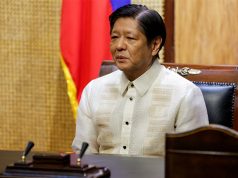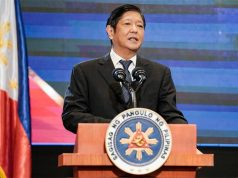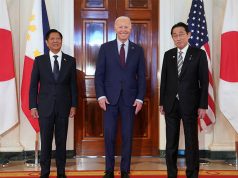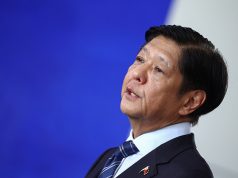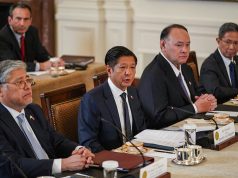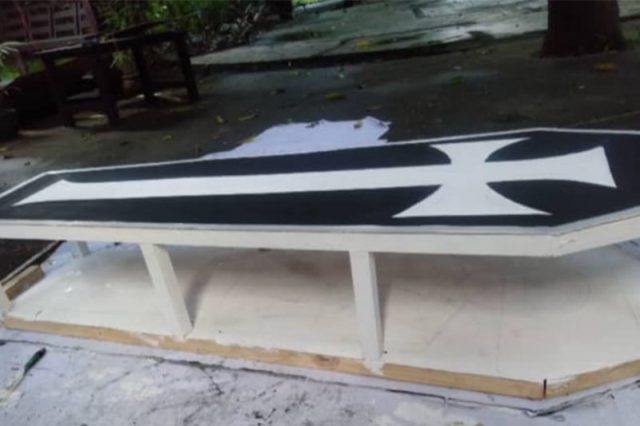
A group of progressive artists is bringing a “coffin” for the oathtaking of the 17th president of the country.
Panday Sining shared that they recreated the mock coffin thrown during late Ferdinand Marcos Sr.‘s fifth State of the Nation Address in January 1970.
The coffin is called the “Kabaong ng Demokrasya” and it will be used for the demonstrations during the inauguration of president-elect Ferdinand “Bongbong” Marcos Jr. at the National Museum of Fine Arts in Manila.
The ceremony, which is estimated to be “more or less than two hours,” will mark his induction into his office.
Apart from supporters, there would also be protesters who will hold demonstrations on the same day.
Authorities have urged them to hold rallies at freedom parks siuch as the Plaza Miranda, Plaza Dilao, Plaza Moriones and Liwasang Bonifacio.
Meanwhile, Panday Sining said that the mock coffin will symbolize the “death of democracy and the suppression of the Filipino people’s rights with the return of a Marcos and a Duterte in Malacañang.”
The Duterte refers to Marcos Jr’s running mate in the 2022 elections, vice president-elect Sara Duterte, the incumbent president’s daughter.
Panday Sining secretary general Jae Domingo said that the “coffin” is a remake of the protest art used during the First Quarter Storm in Marcos Sr’s era.
“Noong una siyang isinagawa, ‘yung kabaong ng demokrasya, sinisimbolo niya talaga ‘yung kamatayan ng demokrasya dahil sa patuloy na panunungkulan ni Marcos Sr. noong panahon ng Martial Law era,” she said.
“At ngayon, sa banta ng pagbabalik ng isang Marcos na naman at isang Duterte sa pamahalaan, ay nagpapatuloy ‘yung paghihikahos ng demokrasya,” Domingo added.
Reporter Marc Jayson Cayabyab shared a more detailed explanation behind the concept of the “coffin” on Twitter.
“Noong simula ng makasaysayang Sigwa ng Unang Kwatro o First Quarter Storm noon Enero 26, 1970, binato ng kilusan ang isa ring ‘kabaong ng demokrasya’ sa direksyon ni Ferdinand Marcos Sr,” a picture of a document he uploaded reads.
“Sa pag-upo ni Marcos Jr. ay kasabay ng kamatayan ng demokrasya, ay kamatayan sa reporma sa lupa, pandemic response, ligtas na balik eskwela, nakabubuhay na sahod,” the document added.
Progressive artists group Panday Sining recreates the coffin thrown at the late dictator Ferdinand Marcos Sr. on his 5th State of the Nation Address at the National Museum on Jan. 20, 1970. 📷 : Panday Sining @PhilippineStar @onenewsph pic.twitter.com/UW6cvGqJQN
— Marc Jayson Cayabyab (@mjaysoncayabyab) June 28, 2022
Panday Sining cited the painting by Juanito Torres as reference.
The artwork depicted the rally at the National Museum of Fine Arts—then the Congress building—on Jan. 26, 1970, when 50,000 people, mostly students, gathered to protest Marcos Sr’s fifth SONA.
Panday Sining cited this painting by Juanito Torres that depicted the rally at the National Museum on Jan. 26, 1970, when 50,000 people, mostly students, gathered to protest Marcos Sr.'s 5th SONA. The demonstration sparked the period of civil unrest called First Quarter Storm. pic.twitter.com/fStTkLDdhg
— Marc Jayson Cayabyab (@mjaysoncayabyab) June 28, 2022
The protesters wanted Marcos Sr to promise he would not seek power beyond the two terms prescribed to him by the 1935 Constitution. Others wanted more systematic political reforms.
After he conducted his speech, Marcos Sr was jeered by the crowd which reportedly started to throw pebbles, paper balls and effigies that included a mock coffin.
“Student unrest that began in the late 1960s spilled into the first years of the 1970s, starting the decade with protest marches and demonstrations that turned violent when dispersed by the police with truncheons and tear gas,” historian Ambeth Ocampo said in a column before.
Multi-awarded writer Butch Dalisay also wrote a personal account of what happened during the event as a participant.
“We filed out of our assembly grounds on the UST campus toward the Luneta, where large crowds had already gathered, some sporting the streamers of more vocal militants like the KM (Kabataang Makabayan) and SDK (Samahan ng Demokratikong Kabataan) — whom, at that point, I held in both suspicion and awe,” he wrote in a column.
“I was too far to listen to the speeches being made by the likes of Gary Olivar, whom my high-school English teacher had held up for me as a bright young man worth emulating,” the writer added.
“When things started flying through the air, beginning with the mock coffin someone had brought along to exemplify the death of democracy, and the police began wielding their truncheons, I scampered for the life of me, muttering oaths under my breath directed at both the police and the radicals for spoiling what had been a very nice day,” Dalisay continued.
The demonstrations sparked a period of civil unrest during the first quarter of 1970, also known as the “First Quarter Storm.”
Rallies became more frequent and their dispersal reportedly became more violent.
The event was succeeded by the Plaza Miranda bombing, the rise and fall of the Diliman commune, and the suspension of the writ of habeas corpus.
By September 1972, Marcos Sr placed the country under Martial Law, which would last for nine years.




